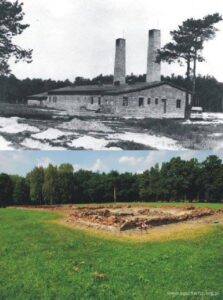- Homepage
- Uncategorized
- Auschwitz-Birkenau in March 1943 – A historic turning point in the camp complex
Auschwitz-Birkenau in March 1943 – A historic turning point in the camp complex
On March 22, 1943, Crematorium IV was completed at the German concentration and extermination camp Auschwitz II-Birkenau. This day marks another chapter in the systematic implementation of the Nazi extermination policy. Construction work began in the fall of 1942. With the completion of Crematorium IV, the camp had another facility for the mass murder of people—especially Jews from all over Europe.
The building was constructed on one level. It essentially consisted of an undressing room, a gas chamber area, and the incineration section with an eight-oven crematorium. The gas chamber itself was divided into three smaller rooms and had a total area of almost 237 square meters. Gas-tight hatches were located in the outer walls through which Zyklon B was introduced – a poison gas that was lethal within minutes.

In the central part of the building was the so-called undressing room. Here, the victims were forced to undress completely – under the pretext of being disinfected or showered. This perfidious deception was part of the cruel system designed to keep the victims ignorant of their fate until the last moment.
The technical design of Crematorium IV was planned by German engineers and the Topf & Sons company. The company supplied the ovens and calculated the capacity: According to their figures, up to 768 bodies could be cremated in this building within 24 hours. The efficiency of this murder machine was horrifying and testifies to the industrial dimension of the Holocaust.
The crematorium staff consisted mainly of so-called Sonderkommandos—prisoners forced to work in the gas chambers and crematoria. Their tasks were gruesome: They had to retrieve the corpses from the gas chambers, remove gold teeth, cut hair, and transport the bodies to the furnaces. These prisoners lived isolated from the rest of the camp—their life expectancy was short because they knew too many details about the procedures.
On October 7, 1944, a remarkable act of resistance took place. Members of the Sonderkommando (special commando) at Birkenau organized an uprising. Using contraband weapons and explosives that female prisoners had brought into the camp from the munitions factory, they set fire to Crematorium IV. It was severely damaged and subsequently dismantled by the SS. Many of the insurgents were captured and executed, but their courage remains a symbol of human resistance against the unimaginable.

Today, only ruins remain of the crematorium at IV. The Auschwitz-Birkenau Memorial has preserved the remains to illustrate the dimensions of the murder sites to visitors. Information panels and models on site help understand the processes and functions of the buildings—without violating the dignity of the victims.
The story of Crematorium IV is a painful but necessary chapter in German and European remembrance culture. It reminds us how technical planning, bureaucratic organization, and ideological blindness led to industrial mass murder. It is our duty to keep this memory alive—not only out of respect for the victims, but also as a warning for the future.

The events of March 22, 1943, and the subsequent uprising of October 1944 reveal two sides of the camp reality: the cold-blooded efficiency of the murder and the desperate humanity of those who resisted despite all circumstances.
Auschwitz today is a symbol of the Holocaust, but also of the importance of remembrance, education, and responsibility. The history of Crematorium IV demonstrates how important it is not to forget—and to actively combat all forms of hatred, anti-Semitism, and contempt for humanity.




